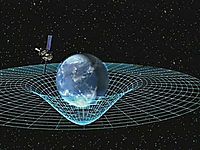
Photo from wikipedia
By analyzing Newton's rings, often encountered in interferometry, the parameters of spherical surfaces such as the rings' center and the curvature radius can be estimated. First, the classical convolutional neural… Click to show full abstract
By analyzing Newton's rings, often encountered in interferometry, the parameters of spherical surfaces such as the rings' center and the curvature radius can be estimated. First, the classical convolutional neural networks, visual geometry group (VGG) network and U-Net, are applied to parameter estimation of Newton's rings. After these models are trained, the rings' center and curvature radius can be obtained simultaneously. Compared with previous analysis methods of Newton's rings, it is shown that the proposed method has higher precision, better immunity to noise, and lower time consumption. For a Newton's rings pattern of ${{640}} \times {{480}}$ pixels comprising ${-}{{5}}\;{\rm{dB}}$ Gaussian noise or 60% salt-and-pepper noise, the parameters can be estimated by the VGG model in 0.01 s, the error of the rings' center is less than one pixel, and the error of curvature radius is lower than 0.5%.
Journal Title: Applied optics
Year Published: 2021
Link to full text (if available)
Share on Social Media: Sign Up to like & get
recommendations!